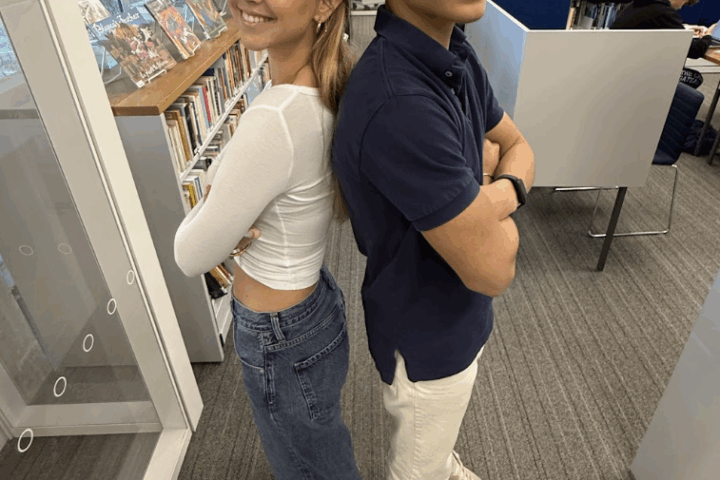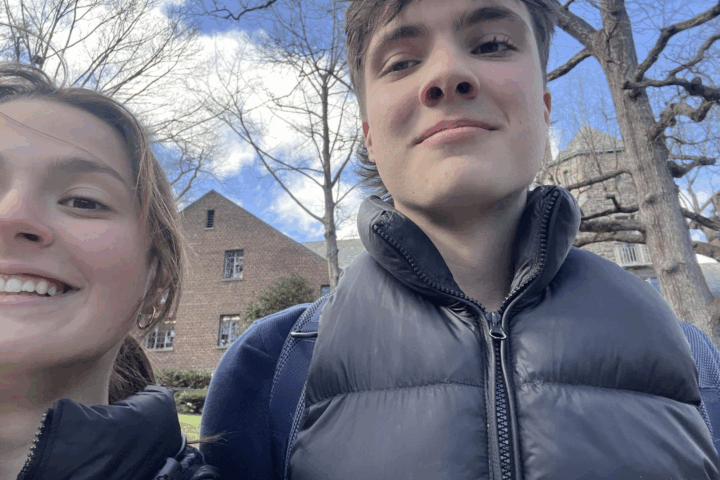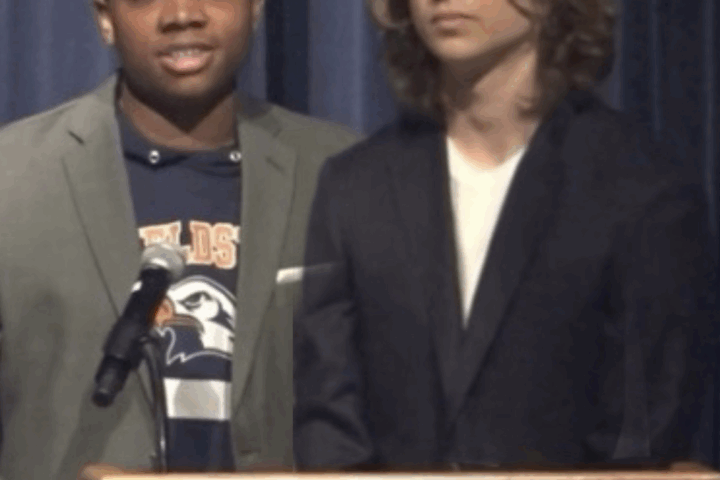In 1971, Mark Stracke dropped out of NYU, not knowing what he wanted to do with his life. In 1977, he was asked to start a photography program here, at the Fieldston School. Now, he is retiring from his 46-year position as a photography instructor, which included 35 years as Chair of the Visual Arts department. Colleagues Nancy Banks and Maura Furfey noted that Stracke served under 8 principals, worked with 9 heads of school, guided 11 advisories to graduation, coached 25 golf and cross country teams and participated in 18 ALPS over his years at Fieldston.
Mark Stracke has been snapping pictures ever since his father purchased him a small development kit as a 14-year-old. “Photography has always been a constant for me,” he said. At NYU, Stracke spent hours in the 770s aisle of the library flipping through photography books. College was not helping him settle on a career path, so he dropped out and moved into a loft in Soho with two friends and fellow artists. New York City was in a financial slump, businesses were failing, real estate markets were collapsing, industrialization had set in and once vibrant sections of the city were now neglected, abandoned and unpopular. In other words, Soho was ideal for artists, who could scoop up lofts for cheap rents or buy buildings at affordable prices (sometimes collectively). There, they started a movers business together, but one of his friends soon convinced him that if he didn’t want to be a mover for the rest of his life, he should get a college degree. He knew he wanted to be an artist, but not necessarily a photographer. So, he re-entered NYU in 1974 to receive an art education degree. And that’s where everything changed.
Stracke had an epiphany one day as he watched a picture slowly emerge in a developer. This was his “ta-da” moment in film photography. He saw in an instant, what he had snapped days ago, suddenly reappeared as something tangible and beautiful – a work of art.
Stracke made it his life’s work to bring this same satisfaction to students, an ironic statement given his unconventional road to teaching. He dropped out of NYU precisely because it was not helping him settle on a career, only to end up re-entering NYU to pursue a degree in art education. His friend and roommate in Soho had successfully convinced him that if he wished to pursue a career in art, or any other career for that matter (he was working as a mover at the time), he would need a college degree. His art education degree required that he spend time as a student teacher/intern. He was presented with two options for this work: the High School of Art and Design, and Fieldston. He ended up choosing Fieldston for its familiarity – he went to a small private high school growing up and knew the independent school world. His teaching job here was his first out of college.
Rowhan Daly, a recently graduated Fieldston photography major, fondly recounts his years in Stracke’s classes: “By taking us on a journey beginning with building our own pinhole cameras, working our way through film cameras, and eventually digital ones, Mr. Stracke helped us to learn and appreciate every small, seemingly unimportant detail behind each picture.”
His colleague and faculty advisor to the Fieldston News, Bob Montera, with whom he coached cross country and “ran the lengths of Manhattan and the Bronx,” noted that Stracke views the world with an intentional eye. “When you run with Stracke you always see the landscape differently. You’re constantly taking photos in your head.”
Montera went on to rave about Stracke’s fine eye in other areas. “There are these technological moments when something new catches on, and he’s the first one out of the gate. He was savvy with computers, the internet and the digital world long before others were. He pioneered their use at Fieldston in the Upper School and made it all user-friendly. Before Tech was a department, there was Stracke. Mark is a movie buff, and we ran ALPs on everything from Film Noir, Martin Scorsese, John Ford, Sidney Lumet, documentaries, New York City cinema, to Japanese cinema. He’s always watched financial markets very closely and has all the instincts of a sound wealth manager. He is especially shrewd with real estate – he moved to Soho when few people wanted to live there, and then moved to Williamsburg when Soho grew too expensive. He ended up leaving Williamsburg for the same reason. This time for Riverdale.” Montera takes this to mean that Riverdale will be the next hotspot. Can you imagine that?
Stracke was similarly ahead of the curve with interdisciplinary learning, working with English and history teachers, and with a class called ISS Interdisciplinary Senior Seminar with John Aune, Clare Mottola, Jon Lambert and Montera, which ran for a decade. “Ten students. Five teachers interlaced between them. Wholly student taught. The teachers acted like reference works when consultation was needed. Remarkable learning experience.”
Stracke’s pedagogy is all about subtlety, appreciation for the creative process, and finding the extraordinary in the mundane. Though I appreciate well-shot photos, I’ve always struggled to see the room for creative expression in the art form. Photographers capture things that already exist, as they exist; painters, sculptors, and filmmakers create images and their accompanying meanings. I asked Stracke where he sees creative decision-making in photography. He said he tells his students there are three main decisions when taking a photo, which he presented to me like a catechism – What is my subject, why am I interested in this subject, and how do I make this come across in my photo? “Where will the camera be when I take the picture?” and “When will I push the button?”
“Then there’s the final output,” Stracke said, the gears in his brain clearly turning. “Is it a series or just a single picture? Is it gonna be a print, on a screen, etc.?” He told me that beginning students tend to want to be done with the photograph as soon as they see it. But “a lot of your signature and artistic expression,” he said, “comes from how you take and develop your photos, to the point that you can identify the photographer from their work.”
Stracke described that photography in its most basic form is merely an endeavor to capture and remember a place in time. This alone can be quite powerful. He discussed how even the simplest photos can be such poignant timestamps, and, like a fine wine, deepen in meaning with age. Some of his old photographs of day-to-day life – people, storefronts, NYC street corners – would look totally different today. They bear witness to youth, gentrification, technological innovation and fashion trends. But Stracke encourages his students not to just mindlessly click the button at whatever’s in front of them, but to really think about what they want to capture and why. And then to make it come to life.
Stracke’s thoughtfulness is the backbone of his teaching style. “His ever-thoughtful and insightful personality allowed him to help us ensure our ideas and visions were truly captured in our work,” remarked Daly. Montera shared this praise: “He knows how to bring out the best in the students, and he knows how to bring out the best in his colleagues.”
Stracke characterized his days here as a “constant learning process,” highlighted by moments of “creative problem-solving.” When I asked him what he loved about Fieldston, he answered without hesitation: “Working with the students…and getting to think about photography a lot.”
Nancy Banks, Student Activities and history teacher, observed: “Mark can often be found ‘teaching’ his classes through conversation – he is always eliciting student ideas and opinions in order to help them understand various approaches to photography, and in this way has inspired generations of students who have gone on to be artists and photographers themselves.”
Maura Furfey, Spanish language teacher, and Nancy Banks also said: “He is a fierce advocate for all of the arts at Fieldston, not as an add-on or extracurricular, but as a core part of the school’s mission and as critical to student’s growth as individuals. Mark is also a truth-teller – he never shies away from speaking truth to power, especially when it comes to students’ engagement with the arts and interdisciplinary learning at Fieldston. Given the number of changes that have taken place over the years, we often find ourselves talking about the importance of institutional memory. If you truly want to understand the way Fieldston was and how it has evolved, for the better, talk to Mark Stracke. He knows.”
In his retirement, he is most looking forward to having more time to take photos and to be able to travel to do so. Though he loved his time at Fieldston, he described it as an “all-encompassing job.” No longer will his artistic projects – nature photographs from out his apartment window, trips to Cape Code, Vermont, New Hampshire, and Maine – be pushed to weekends and breaks.
After such an illustrious career at Fieldston, there is no telling what Mark Stracke will accomplish in his retirement. But it’s safe to say that as he’s always been, he will always be “on the cutting edge of something.” And he will never stop taking photos.
Stracke’s Website: https://stracke.com/
Stracke’s Instagram Page: https://www.instagram.com/mark_stracke/









